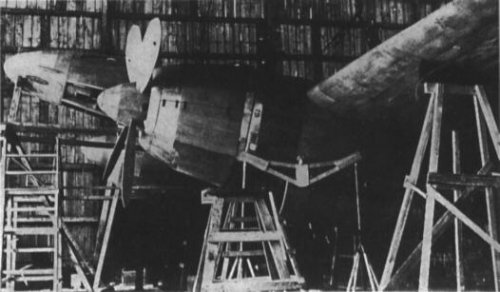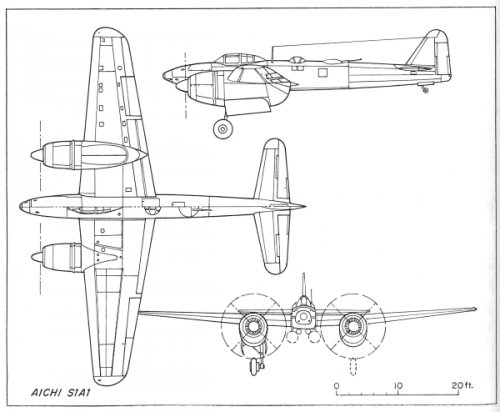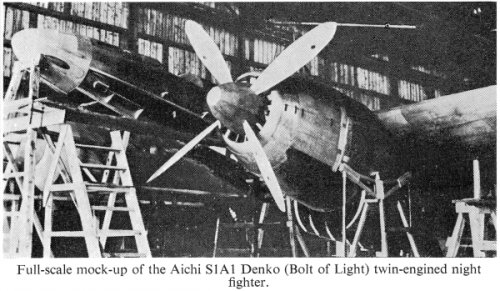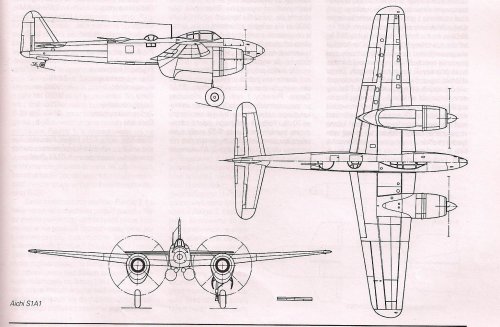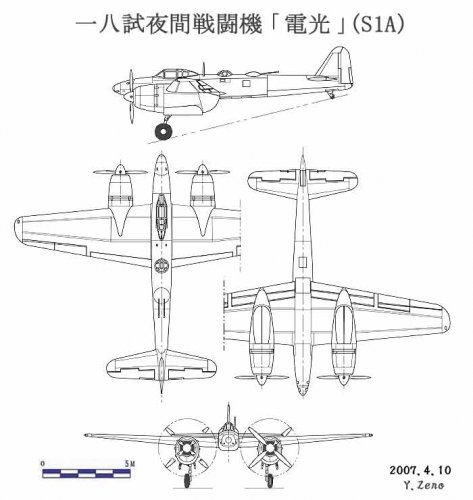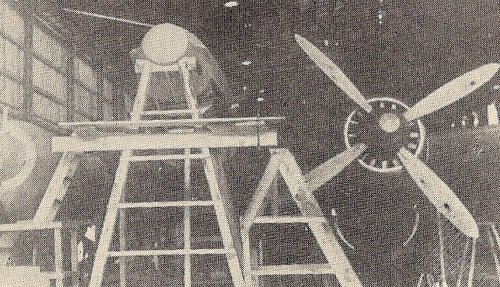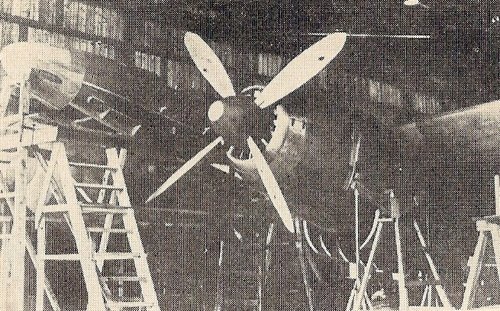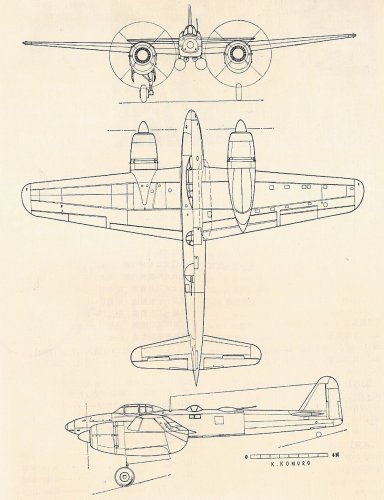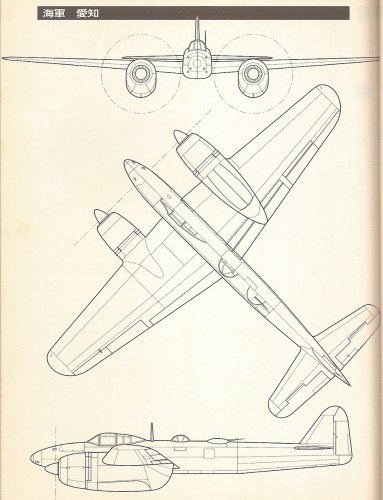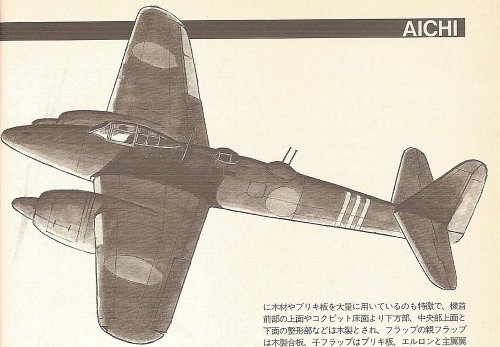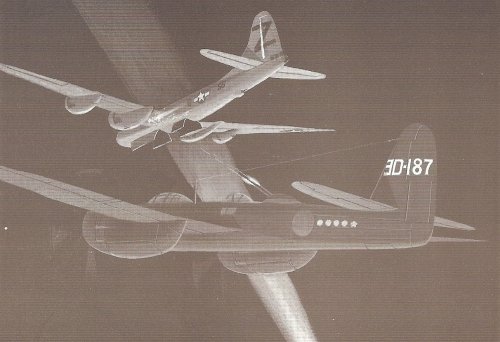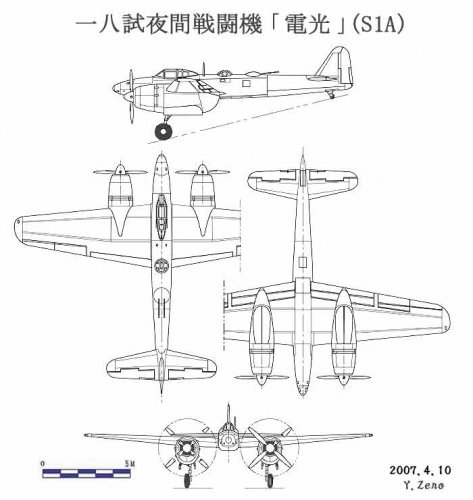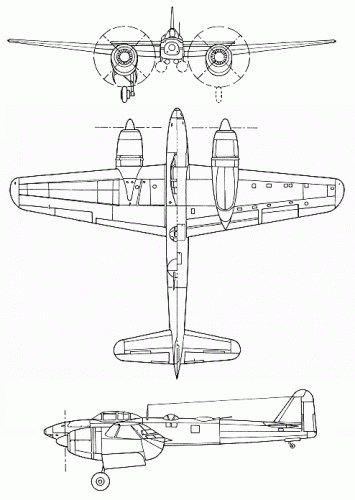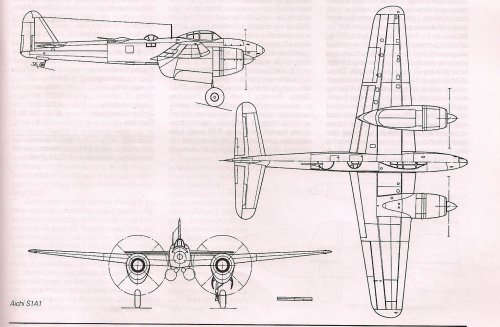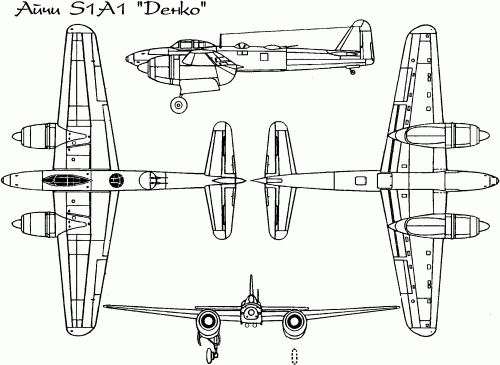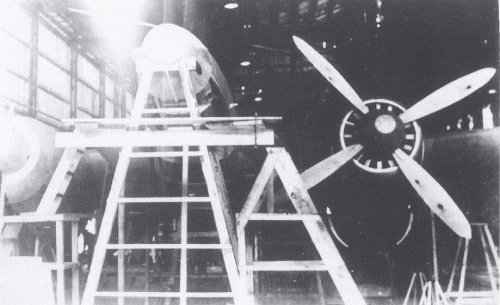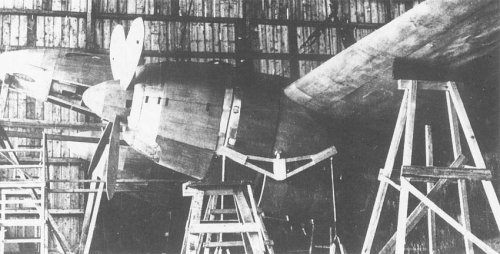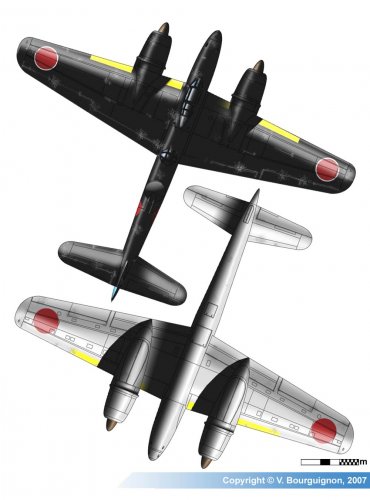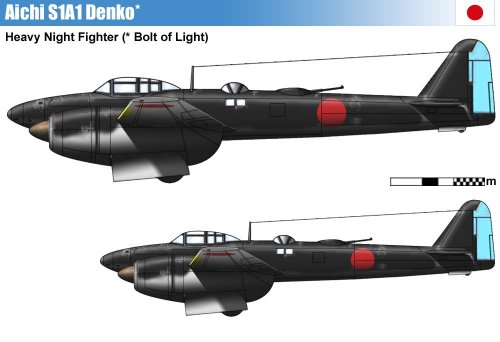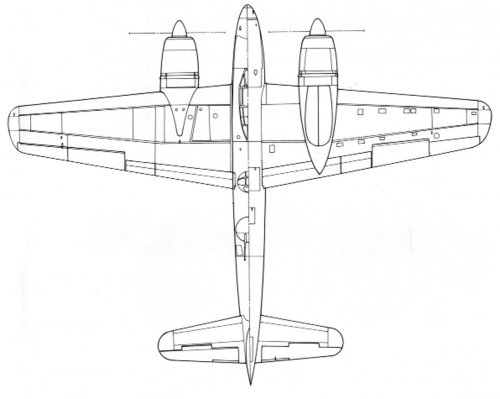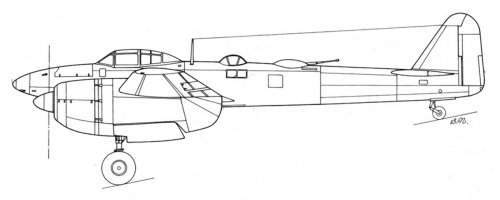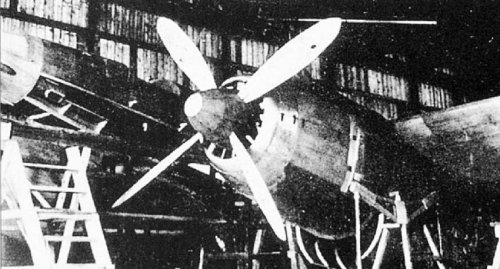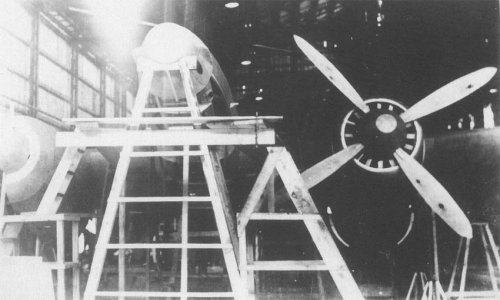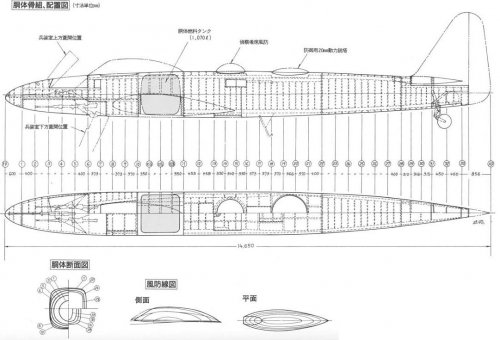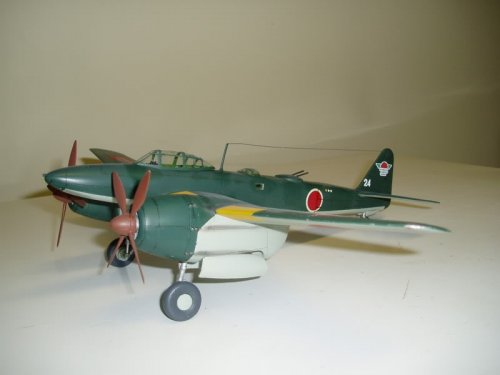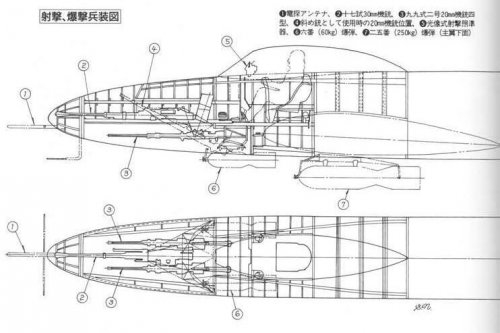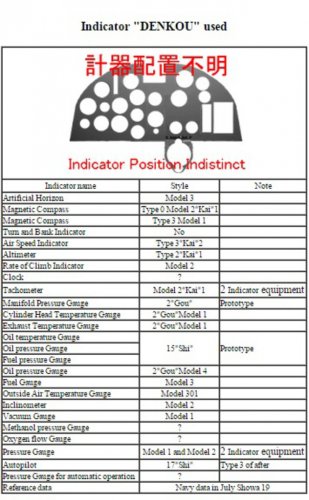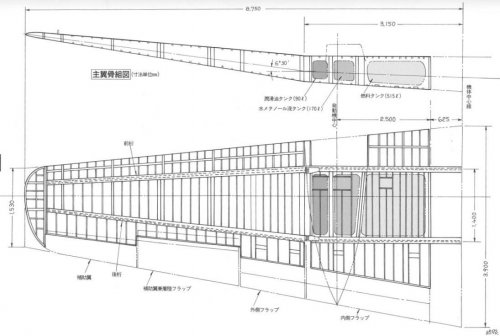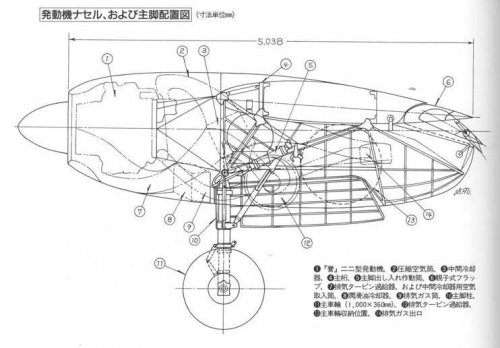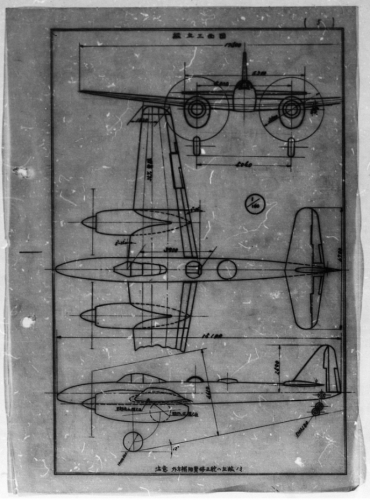You are using an out of date browser. It may not display this or other websites correctly.
You should upgrade or use an alternative browser.
You should upgrade or use an alternative browser.
Aichi S1A Denkô Night Fighter (AM-25)
- Thread starter hesham
- Start date
- Joined
- 8 January 2006
- Messages
- 1,612
- Reaction score
- 763
The interesting thing about the S1A1 is that it was a radar-equipped nightfighter with the radar antenna enclosed in a wooden radome rather than "hanging in the wind". That's a fairly sophisticated radar for the time period and it would've been interesting to see the results they'd have gotten with it.
Hello best people there was a late war project of an nightfighter by Aichi.
It was named the Aichi S1A1 Denkoh i believe it means bolt of light,it was planned with remote
controlled gun turrets and a radar.
I believe a parabolic shaped antenna,does some one have for me drawings or artist impressions
of this fighter? i understand there were even photos of an mock up.
It was named the Aichi S1A1 Denkoh i believe it means bolt of light,it was planned with remote
controlled gun turrets and a radar.
I believe a parabolic shaped antenna,does some one have for me drawings or artist impressions
of this fighter? i understand there were even photos of an mock up.
could some one tell me what type radar was planned for the Denkoh? was it indeed a parabolic
antenna? or stay the Japanese to the Yagi type antenna configuration?
I read that the Japanese Electronic engineers were indeed developing a 10cm radar,maybe with German acquired documents.It believed to be similar to the German Rotterdam gerate.
Anyway the Japanese were working on more advanced radarsystems,I'm curious of they were planned on the S1A1 Denkoh or other planned aircraft
regards T-50
antenna? or stay the Japanese to the Yagi type antenna configuration?
I read that the Japanese Electronic engineers were indeed developing a 10cm radar,maybe with German acquired documents.It believed to be similar to the German Rotterdam gerate.
Anyway the Japanese were working on more advanced radarsystems,I'm curious of they were planned on the S1A1 Denkoh or other planned aircraft
regards T-50
red admiral
ACCESS: Top Secret
- Joined
- 16 September 2006
- Messages
- 1,815
- Reaction score
- 2,401
The s1a1 nightfighter was to bee equiped whith the TAMA3 centermetric radar discribed in this link[http://www.star-games.com/exhibits/japaneseradar/japaneseradar.html/url]
windswords
ACCESS: Secret
- Joined
- 19 May 2009
- Messages
- 389
- Reaction score
- 218
I hope someone can provide me with some info or pics of theprojected Japanese Nightfighter project of the Aichi company.
Its the Aichi S1A1 Denkoh or bolt of lightning in English,It was a two engined fighter with a heavy armamend.
It consisted with heavy guns under the nose of the machine and a remote controlled gun turret on the back,also a 10cm radar set was provided for this very promising machine.
I'm especially interested of pics of modelkids and radar of this machine,Ill hope someone can help me with this
Its the Aichi S1A1 Denkoh or bolt of lightning in English,It was a two engined fighter with a heavy armamend.
It consisted with heavy guns under the nose of the machine and a remote controlled gun turret on the back,also a 10cm radar set was provided for this very promising machine.
I'm especially interested of pics of modelkids and radar of this machine,Ill hope someone can help me with this
blackkite
Don't laugh, don't cry, don't even curse, but.....
- Joined
- 31 May 2007
- Messages
- 8,821
- Reaction score
- 7,721
Hi!
http://www.geocities.co.jp/Bookend-Ohgai/3853/jnrs/jnrsC235i.htm
Source:JAPAN PROJECT AIRCRAFT;KOEI ISBN4-87719-490-8 C0031,
INPERIAL LAPANESE NAVY WARPLANE;GREEN ARROW ISBN4-7663-3161-3 C0076 and My No.2 bible
Span:17.5m, Length:14.25m, Height:4.25m, Empty weight:7320kg, Gross weight:10180kg, Engine:Nakajima Homare22(2000hp take off), Service ceiling:12000m, Range:1600km, Estimated max Speed:635km/h with oxgen injection(requested max speed was 685km/h)
http://www.geocities.co.jp/Bookend-Ohgai/3853/jnrs/jnrsC235i.htm
Source:JAPAN PROJECT AIRCRAFT;KOEI ISBN4-87719-490-8 C0031,
INPERIAL LAPANESE NAVY WARPLANE;GREEN ARROW ISBN4-7663-3161-3 C0076 and My No.2 bible
Span:17.5m, Length:14.25m, Height:4.25m, Empty weight:7320kg, Gross weight:10180kg, Engine:Nakajima Homare22(2000hp take off), Service ceiling:12000m, Range:1600km, Estimated max Speed:635km/h with oxgen injection(requested max speed was 685km/h)
Attachments
Hi blackkite San, thank you very much for the pics and link!
very interesting photo of the mock up in front position, I haven't seen only pics of the mock up taken from the side.
the last pic is for me very rare and awesome!
Do you know something about the planned radar set of the Denkoh? I presume this was a parabolic type antenna,and it worked on the 10cm band
With best regards
Gerald
very interesting photo of the mock up in front position, I haven't seen only pics of the mock up taken from the side.
the last pic is for me very rare and awesome!
Do you know something about the planned radar set of the Denkoh? I presume this was a parabolic type antenna,and it worked on the 10cm band
With best regards
Gerald
windswords
ACCESS: Secret
- Joined
- 19 May 2009
- Messages
- 389
- Reaction score
- 218
- Joined
- 25 June 2009
- Messages
- 14,758
- Reaction score
- 6,164
blackkite said:Wow it's Japanese Uhu!
Much more handsome! Reminds me of the Ki-83 too...
- Joined
- 9 October 2009
- Messages
- 21,979
- Reaction score
- 13,647
Would caused a fair bit of trouble for the USAAC if it had manged to reach service in even limited numbers, IMHO.
blackkite
Don't laugh, don't cry, don't even curse, but.....
- Joined
- 31 May 2007
- Messages
- 8,821
- Reaction score
- 7,721
Thanks! But Uhu is one of the most handsome fighter for me.
To hear B-29's completion in 1943, the INJ ordered Aichi to develop authentic night fighter.
The IJN's request for this night fighter was as follows.
Maximum speed ; 685km/h(370kt)/9000m, Endurance ; 5hours(4000m), Time climb to 6,000m ; 8 minutes, Take off run ; under 400m, Armament ; 2× 30mm canons, With radar.
Aichi concentrated to develop this fighter with there all resources from November 1943, finished design in May 1944, completed mock up in August 1944. Aichi judged it's maximum speed was only 629km/h(340kt) with Homare(NK9K) engine (IJN's request),they planned to use turbocharger to realize 679km/h(367kt) maximum speed, but it's difficult for Aichi to develop turbocharger quickly, they changed design to use oxygen injection into the engine cylinder and forced cooling fan , then estimated maximum speed became 635km/h(343kt) and finally became 588km/h(318kt). The armaments ; 2×30mm or 20mm canon(nose) and 2 ×20mm remote controlled turret behind the cockpit. There was a speed brake bottom of the fuselage for same speed flight when B-29 interception. No.1 aircraft(95% completed) was destroyed in 3/12/1945 by B-29 bombing prior to destroy B-29.
To hear B-29's completion in 1943, the INJ ordered Aichi to develop authentic night fighter.
The IJN's request for this night fighter was as follows.
Maximum speed ; 685km/h(370kt)/9000m, Endurance ; 5hours(4000m), Time climb to 6,000m ; 8 minutes, Take off run ; under 400m, Armament ; 2× 30mm canons, With radar.
Aichi concentrated to develop this fighter with there all resources from November 1943, finished design in May 1944, completed mock up in August 1944. Aichi judged it's maximum speed was only 629km/h(340kt) with Homare(NK9K) engine (IJN's request),they planned to use turbocharger to realize 679km/h(367kt) maximum speed, but it's difficult for Aichi to develop turbocharger quickly, they changed design to use oxygen injection into the engine cylinder and forced cooling fan , then estimated maximum speed became 635km/h(343kt) and finally became 588km/h(318kt). The armaments ; 2×30mm or 20mm canon(nose) and 2 ×20mm remote controlled turret behind the cockpit. There was a speed brake bottom of the fuselage for same speed flight when B-29 interception. No.1 aircraft(95% completed) was destroyed in 3/12/1945 by B-29 bombing prior to destroy B-29.
- Joined
- 9 October 2009
- Messages
- 21,979
- Reaction score
- 13,647
So if they had just left the engine alone, they would have not only finished development a lot sooner, but might have gotten a 22kt higher maximum speed?
blackkite
Don't laugh, don't cry, don't even curse, but.....
- Joined
- 31 May 2007
- Messages
- 8,821
- Reaction score
- 7,721
This description is from my No.2 bible. It include contradiction. But I think Denko's maximum speed 588km/h(It's Aichi's data) was proper because Homare was not so powerful compared with it's specification at the day because of low quality fuel,large size same as Ginga and heavy weight(10ton). I think Aichi considered this fact. I believe Denko could mark more than 629km/h(340kt) without oxygen injection using high quality fuel and spark plug. Sorry I can't find the information about Denko's radar.
- Joined
- 9 October 2009
- Messages
- 21,979
- Reaction score
- 13,647
blackkite said:This description is from my No.2 bible. It include contradiction. But I think Denko's maximum speed 588km/h(It's Aichi's data) was proper because Homare was not so powerful compared with it's specification at the day because of low quality fuel. I think Aichi considered this fact. I believe Denko could mark more than 629km/h(340kt) without oxygen injection using high quality fuel and spark plug.
Good point. I hadn't taken the increasingly dire fuel situation at the time into account.
Yes it was but its closer to the American black widow night figher,because it has like his US counter part remote gun turrets and separated cockpits.blackkite said:Wow it's Japanese Uhu!
Heinkel He-219 has its crew placed in one cockpit.But their were both very advanced nightfighter types
blackkite
Don't laugh, don't cry, don't even curse, but.....
- Joined
- 31 May 2007
- Messages
- 8,821
- Reaction score
- 7,721
Hi! Clear mock up images and three side view drawing.
Attachments
Beauty
blackkite
Don't laugh, don't cry, don't even curse, but.....
- Joined
- 31 May 2007
- Messages
- 8,821
- Reaction score
- 7,721
Thanks.
Denko turbocharged engin plan, wing structure, panel and nose.
Denko prototype which destroyed when under construction by B-29 bombing had oxgen injection system instead of turbo charger.
Turbocharged engin plan
① : Homare type 22 engine
② : Compressed air duct from torbocharger to engine
③ : Intercooler
⑦ : Turbocharger and intercooler air intake
⑨ : engine exhaust gas pipe
⑫ : Turbocharger
⑭ : Turbocharger exhaust gas outlet
Wing structure
燃料タンク : Fuel tank
水メタノール液タンク : Water/Methanol liquid tank(So Denko prototype had Water/Methanol injection system(ADI system) in parallel with Oxgen injection system)
潤滑油タンク : Oil tank
フラップ : Flap
Nose
①Radar antenna
②17-shi 30mm cannon
③Type 99 2-go 4-gata 20mm cannon
④Type 99 2-go 4-gata 20mm cannon(The position when used as inclined cannon)
We must add radar antenna at the Denko nose.
Generally Denko shoulder turret was used for B-29 night interception same as Gekko fixed forward inclined cannon.
Source : Internet
Denko turbocharged engin plan, wing structure, panel and nose.
Denko prototype which destroyed when under construction by B-29 bombing had oxgen injection system instead of turbo charger.
Turbocharged engin plan
① : Homare type 22 engine
② : Compressed air duct from torbocharger to engine
③ : Intercooler
⑦ : Turbocharger and intercooler air intake
⑨ : engine exhaust gas pipe
⑫ : Turbocharger
⑭ : Turbocharger exhaust gas outlet
Wing structure
燃料タンク : Fuel tank
水メタノール液タンク : Water/Methanol liquid tank(So Denko prototype had Water/Methanol injection system(ADI system) in parallel with Oxgen injection system)
潤滑油タンク : Oil tank
フラップ : Flap
Nose
①Radar antenna
②17-shi 30mm cannon
③Type 99 2-go 4-gata 20mm cannon
④Type 99 2-go 4-gata 20mm cannon(The position when used as inclined cannon)
We must add radar antenna at the Denko nose.
Generally Denko shoulder turret was used for B-29 night interception same as Gekko fixed forward inclined cannon.
Source : Internet
Attachments
- Joined
- 11 June 2014
- Messages
- 1,542
- Reaction score
- 2,902
Planned production for Aichi S1A1 was for 1720 aircraft . From volumes of United States Strategic Bombing Survey that you can find on archive.org.
Raa
ACCESS: Restricted
- Joined
- 7 December 2020
- Messages
- 40
- Reaction score
- 115
The Denko's equipped Radar was not TAMA3, but 18試空6号無線電信機2型(Prototype 18 Air Mark 6 Model 2) to be exact. Model 1 of the Radar was equipped in the J1N1 Gekko.
The antenna geometry is as shown by Blackkite above.
By the way, where can i find reports from the US bomber wings that bombed Japan? The Prototype No.1 of the Denko was destructed by bombing in June 9, 1945 and Prototype No.2 was destructed by bombing in "close to end of the war". However, there is also information that the prototype No.2 was incinerated by order of the military at the end of the war.
Does anyone know a record of the bombing of the bombardment wing on June 9, 1945 and the bombing Gifu Prefecture near the end of the war?
The antenna geometry is as shown by Blackkite above.
By the way, where can i find reports from the US bomber wings that bombed Japan? The Prototype No.1 of the Denko was destructed by bombing in June 9, 1945 and Prototype No.2 was destructed by bombing in "close to end of the war". However, there is also information that the prototype No.2 was incinerated by order of the military at the end of the war.
Does anyone know a record of the bombing of the bombardment wing on June 9, 1945 and the bombing Gifu Prefecture near the end of the war?
Temistocle
ACCESS: Secret
- Joined
- 9 December 2009
- Messages
- 247
- Reaction score
- 506
Hi, there is this report of the Kawanishi, Kawasaki and Aichi plants bombing on 9 June 1945:The Denko's equipped Radar was not TAMA3, but 18試空6号無線電信機2型(Prototype 18 Air Mark 6 Model 2) to be exact. Model 1 of the Radar was equipped in the J1N1 Gekko.
The antenna geometry is as shown by Blackkite above.
By the way, where can i find reports from the US bomber wings that bombed Japan? The Prototype No.1 of the Denko was destructed by bombing in June 9, 1945 and Prototype No.2 was destructed by bombing in "close to end of the war". However, there is also information that the prototype No.2 was incinerated by order of the military at the end of the war.
Does anyone know a record of the bombing of the bombardment wing on June 9, 1945 and the bombing Gifu Prefecture near the end of the war?
21st Bomber Command Tactical Mission Report 191-192-193
There is a damage assessment of the Aichi plants (mission 193) at pages 44-48, with a map of the destroyed/damaged buildings.
Another bombing of the Aichi plants was made on mission 287 (24 July 1945), as detailed in this report:
21st Bomber Command Tactical Mission Report 284-290
Last edited:
Raa
ACCESS: Restricted
- Joined
- 7 December 2020
- Messages
- 40
- Reaction score
- 115
Thanks Mr. Temistocle!!Hi, there is this report of the Kawanishi, Kawasaki and Aichi plants bombing on 9 June 1945:The Denko's equipped Radar was not TAMA3, but 18試空6号無線電信機2型(Prototype 18 Air Mark 6 Model 2) to be exact. Model 1 of the Radar was equipped in the J1N1 Gekko.
The antenna geometry is as shown by Blackkite above.
By the way, where can i find reports from the US bomber wings that bombed Japan? The Prototype No.1 of the Denko was destructed by bombing in June 9, 1945 and Prototype No.2 was destructed by bombing in "close to end of the war". However, there is also information that the prototype No.2 was incinerated by order of the military at the end of the war.
Does anyone know a record of the bombing of the bombardment wing on June 9, 1945 and the bombing Gifu Prefecture near the end of the war?
21st Bomber Command Tactical Mission Report 191-192-193
There is a damage assessment of the Aichi plants (mission 193) at pages 44-48, with a map of the destroyed/damaged buildings.
Another bombing of the Aichi plants was made on mission 287 (24 July 1945), as detailed in this report:
21st Bomber Command Tactical Mission Report 284-290
Denko's Prototype No.1 was assembling in the Aichi aircraft's Funakata-aircraft plant of the Aichi-prefecture. But, it is destroyed by bombing in 9 june 1945. Therefore, Denko's Prototype No.2 was assembled at the Yōrō Machine Parts Manufacturing Plant in Gifu Prefecture, adjacent to the evacuated Aichi Prefecture.
The picture of the Target 198 and 2010 in 48 page on "21st Bomber Command Tactical Mission Report 191-192-193" is cofused me a little, but i think it is means Aichi aircraft's Funakata-aircraft plant. American command must have misunderstood a bit. The Target 198 and 2010 are same plant, so both are Aichi aircraft's Funakata-aircraft plant. and Funakata-aircraft plant has no attached engine plant.
Anyway, I was able to confirm bombing to Funakata-plant of the Aichi aircraft of 9 june 1945.
The second report "21st Bomber Command Tactical Mission Report 284-290" is showing bombing to Eitoku-plant of Aichi aircraft. This plant has nothing to do with Denko.
Well, next, need to find a bombing report to Gifu-prefecture neart the end of the war....
Raa
ACCESS: Restricted
- Joined
- 7 December 2020
- Messages
- 40
- Reaction score
- 115
Wait, I may have made a serious mistake. Denko's prototype No.1 was assembling in the Aichi aircraft's Eitoku-aircraft plant.Thanks Mr. Temistocle!!Hi, there is this report of the Kawanishi, Kawasaki and Aichi plants bombing on 9 June 1945:The Denko's equipped Radar was not TAMA3, but 18試空6号無線電信機2型(Prototype 18 Air Mark 6 Model 2) to be exact. Model 1 of the Radar was equipped in the J1N1 Gekko.
The antenna geometry is as shown by Blackkite above.
By the way, where can i find reports from the US bomber wings that bombed Japan? The Prototype No.1 of the Denko was destructed by bombing in June 9, 1945 and Prototype No.2 was destructed by bombing in "close to end of the war". However, there is also information that the prototype No.2 was incinerated by order of the military at the end of the war.
Does anyone know a record of the bombing of the bombardment wing on June 9, 1945 and the bombing Gifu Prefecture near the end of the war?
21st Bomber Command Tactical Mission Report 191-192-193
There is a damage assessment of the Aichi plants (mission 193) at pages 44-48, with a map of the destroyed/damaged buildings.
Another bombing of the Aichi plants was made on mission 287 (24 July 1945), as detailed in this report:
21st Bomber Command Tactical Mission Report 284-290
Denko's Prototype No.1 was assembling in the Aichi aircraft's Funakata-aircraft plant of the Aichi-prefecture. But, it is destroyed by bombing in 9 june 1945. Therefore, Denko's Prototype No.2 was assembled at the Yōrō Machine Parts Manufacturing Plant in Gifu Prefecture, adjacent to the evacuated Aichi Prefecture.
The picture of the Target 198 and 2010 in 48 page on "21st Bomber Command Tactical Mission Report 191-192-193" is cofused me a little, but i think it is means Aichi aircraft's Funakata-aircraft plant. American command must have misunderstood a bit. The Target 198 and 2010 are same plant, so both are Aichi aircraft's Funakata-aircraft plant. and Funakata-aircraft plant has no attached engine plant.
Anyway, I was able to confirm bombing to Funakata-plant of the Aichi aircraft of 9 june 1945.
The second report "21st Bomber Command Tactical Mission Report 284-290" is showing bombing to Eitoku-plant of Aichi aircraft. This plant has nothing to do with Denko.
Well, next, need to find a bombing report to Gifu-prefecture neart the end of the war....
So the second report of the july 24 shown by Temisocle may be a better report of the bombing of the first prototype of the Denko.
Raa
ACCESS: Restricted
- Joined
- 7 December 2020
- Messages
- 40
- Reaction score
- 115
Result of the more based on many documents research, i think probability is high that Denko no.1 was bombed March 12, 1945 at Aichi Eitoku-aircraft plant and Denko no.2 was incinerationed Augast 15, 1945(The day the war ended in Japan).
Here is the video about the S1A1 Denko by me but, I'm sorry this is in Japanese.
But, take a watch 7:34~28:15, there is many information about construction and Performance of the S1A1 Denko. It is easy to understand even for non-Japanese speakers.
View: https://www.youtube.com/watch?v=-tPwHiQx46A
Here is the video about the S1A1 Denko by me but, I'm sorry this is in Japanese.
But, take a watch 7:34~28:15, there is many information about construction and Performance of the S1A1 Denko. It is easy to understand even for non-Japanese speakers.
Hello, I am a new guy for this forum and I am now doing a lot of research on since plane since she was my favorite plane ever (I even transfered my major from ES to aerospace engineering because of her). So I think I could give some specifications about this plane(thanks for the support of Chachanomizu's youtube video and first-hand resources obtained from aichi koukuki's descendants). However, these first-hand lab reports, blueprints and so on, according to the promise given to aichi koukuki kk, are strictly prohibited to post on any sites of the internet, I will NOT post any links and files but only spoken words that I think could answer some of the questions. Thanks for the understanding.
First, this plane's code is AM25, or some times A90 within Aichi's company, and S1A1 in the IJN. This plane, also called 18 shi-hei sentoki (night fighter projected in Showa 18th, or 1943), was there because the navy wish her to catch and take down the B29s (by the way, the J5N Tenrai was also there at the same time). However at that time, no one knows that B29s would bomb Japan at the altitude of 4000m, thus this plane's fastest speed was at 9000m, and unfortunately she could not catch up with B29 since at 4000m the denko was much slower according to her plan report and performance calculations.
About her speed, denko has two variant types that most people doesn't know, all of them carries the NK9K0 (Homare type 24). The first variant was named Sa, the first letter of Sanso (oxygen), this variant carried liquid oxygen tanks within its engine tanks so that at high attitude where oxygen level is low, the engine's power could be boosted when needed. The second variant is called, the first letter of turbine, this variant carried turbocharger. According to the speed, the Sa's fastest speed was 340s knots at 9000m and Ta's fastest speed was 360s knot at the same alttitude. According to the plans, the first plane will be the plane itself without either liquid O2 or turbocharger, plane No 2 to No 7 were Sa and plane No 8 to No 12 were Ta. (However, only two were built and only one of them were completed).
She also had some crazy designs thanks for her designer Ozaki's talent (he also designed Seiran, Ryusei, Suisei, and Mokusei).
First about her fuselage, her fuselage was separated into five parts-the front part, the cockpit part, the main-wings part, the middle part and the back part. In order to save resources and easilize the way to be constructed, the plane used a lot of wood (like the Tokai), the front part's main weapons' checking gate and nose, the cockpit part's floor, the part around the cockpit's window, the up and down part of the middle part, and the gate for latter landing gear, were all made of wood. Denko's fuselage was weird also because of its shape. The fuselage's front cross-section was oval and round, but the cross-section after the cockpit's window became squares and rectangles. This was because denko carried a 360 degree turrent with two 20mm guns that functioned as Schräge Musik (just like the design of P61), and only a flat surface allowed that turrent to be able to turn. The main structure was considered to be semi-monocoque with 4 main girders made of ESD on each of her angles of the fuselage.
About her wing, in order to be fast, she carried the Heinkel He100-style wing shape which was considered to be a type of laminar flow wing. Also in order to maximize the field of view of the pilot, the denko has a main wing with two sections of different dihedrals. The inner section (section between the wing root and nacelle has a diheral of 2 degrees, and section outside the nacelle has a diheral of 6 degrees. Thus the nacelle could cover the 6 degree part of outer wing when the pilot look left/right and it also maximized the diherals.
Also, this plane has a giant wing load, 238 at that time. As a night fighter, it would be catastrohpic when landing and taking of at night with such wing load. What Ozaki had done to solve that was to introduce something called the secondary flaps. Unlike normal flaps, the secondary flaps have small flaps that were connected to the main flaps (same design at B7A Ryusei and H8K emily), denko had four such flaps with two on each wing. Also, denko has something called flaperon which is a combination of aileron and flaps. During flights, the flaperons behave like normal ailerons, but when taking off and landing such structures behave like flaps. The Denko has four ailerons with two at each wing. The inner ailerons at each wing were secondary flap structure and the outer ailerons at were normal flap structures.
In order to maximize the dihedral to enhance the stability of denko during taking of and landing, Ozaki also introduced the movable wings tip. When the plane put down her flaps, the wing tips could rise up with an angle of 30 degrees, when the flaps went back to position, the wing tips could also go back to where they were.
About her speed, denko has two variant types that most people doesn't know, all of them carries the NK9K0 (Homare type 24). The first variant was named Sa, the first letter of Sanso (oxygen), this variant carried liquid oxygen tanks within its engine tanks so that at high attitude where oxygen level is low, the engine's power could be boosted when needed. The second variant is called, the first letter of turbine, this variant carried turbocharger. According to the speed, the Sa's fastest speed was 340s knots at 9000m and Ta's fastest speed was 360s knot at the same alttitude. According to the plans, the first plane will be the plane itself without either liquid O2 or turbocharger, plane No 2 to No 7 were Sa and plane No 8 to No 12 were Ta. (However, only two were built and only one of them were completed).
She also had some crazy designs thanks for her designer Ozaki's talent (he also designed Seiran, Ryusei, Suisei, and Mokusei).
First about her fuselage, her fuselage was separated into five parts-the front part, the cockpit part, the main-wings part, the middle part and the back part. In order to save resources and easilize the way to be constructed, the plane used a lot of wood (like the Tokai), the front part's main weapons' checking gate and nose, the cockpit part's floor, the part around the cockpit's window, the up and down part of the middle part, and the gate for latter landing gear, were all made of wood. Denko's fuselage was weird also because of its shape. The fuselage's front cross-section was oval and round, but the cross-section after the cockpit's window became squares and rectangles. This was because denko carried a 360 degree turrent with two 20mm guns that functioned as Schräge Musik (just like the design of P61), and only a flat surface allowed that turrent to be able to turn. The main structure was considered to be semi-monocoque with 4 main girders made of ESD on each of her angles of the fuselage.
About her wing, in order to be fast, she carried the Heinkel He100-style wing shape which was considered to be a type of laminar flow wing. Also in order to maximize the field of view of the pilot, the denko has a main wing with two sections of different dihedrals. The inner section (section between the wing root and nacelle has a diheral of 2 degrees, and section outside the nacelle has a diheral of 6 degrees. Thus the nacelle could cover the 6 degree part of outer wing when the pilot look left/right and it also maximized the diherals.
Also, this plane has a giant wing load, 238 at that time. As a night fighter, it would be catastrohpic when landing and taking of at night with such wing load. What Ozaki had done to solve that was to introduce something called the secondary flaps. Unlike normal flaps, the secondary flaps have small flaps that were connected to the main flaps (same design at B7A Ryusei and H8K emily), denko had four such flaps with two on each wing. Also, denko has something called flaperon which is a combination of aileron and flaps. During flights, the flaperons behave like normal ailerons, but when taking off and landing such structures behave like flaps. The Denko has four ailerons with two at each wing. The inner ailerons at each wing were secondary flap structure and the outer ailerons at were normal flap structures.
In order to maximize the dihedral to enhance the stability of denko during taking of and landing, Ozaki also introduced the movable wings tip. When the plane put down her flaps, the wing tips could rise up with an angle of 30 degrees, when the flaps went back to position, the wing tips could also go back to where they were.
Similar threads
-
-
-
IJN Specification 11-Shi (E11, Night Reconnaissance Seaplane, 1936)
- Started by blackkite
- Replies: 8
-
Aichi's Heinkel-based single-/two-/three-seat recce seaplanes
- Started by theponja
- Replies: 2
-
Aichi Navy Experimental Night Reconnaissance Seaplane (AM-16)
- Started by blackkite
- Replies: 0

